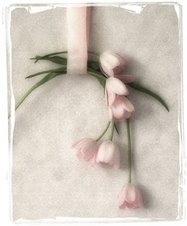
The Haft Sîn
The Traditional Haft Sîn
A major tradition of Norouz is the setting of the Haft Sîn (هفت سین) - the seven 'S's, seven items starting with letter S or sîn (س) in Persian alphabet), which are seven specific items on a table symbolically corresponding to the seven creations and the seven holy immortals protecting them. Today they are changed and modified but some have kept their symbolism. Every family attempts to set as beautiful a Haft Sîn table as they can, as it is not only of special spiritual meaning to them, but also is noticed by visitors to their house during Norouzi visitations and is a reflection of their good taste.
The following list is an example of some common Haft Seen items, though there isn't consensus as to which seven:
sabzeh - wheat, barley or lentil sprouts growing in a dish (symbolizing rebirth)
samanu - a sweet pudding made from wheat germ (symbolizing affluence)
senjed - the dried fruit of the oleaster tree (love)
sîr - garlic (medicine)
sîb - apples, (beauty and health)
somaq - sumac berries (the color of the sunrise)
serkeh - vinegar (age and patience)
sonbol - the fragrant hyacinth flower (the coming of spring)
sekkeh - coins (prosperity and wealth)
Other items on the table may include:
Pastries
Lit candles (enlightenment and happiness)
A mirror
Painted eggs, perhaps one for each member of the family (fertility)
A bowl with two goldfish (life, and the sign of Pisces which the sun is leaving)
A bowl of water with an orange in it (the earth floating in space)
Rose water for its magical cleansing powers
The national colors, for a patriotic touch
a holy book (e.g., the Qura'n, Kita'b-iAqdas, Bible, Torah or the Avesta) or a poetry book (almost always either the Shahname or of Hafez)


هیچ نظری موجود نیست:
ارسال یک نظر